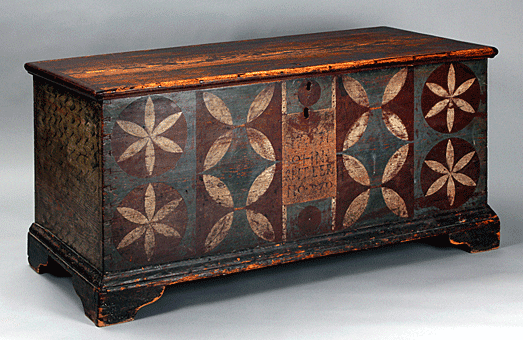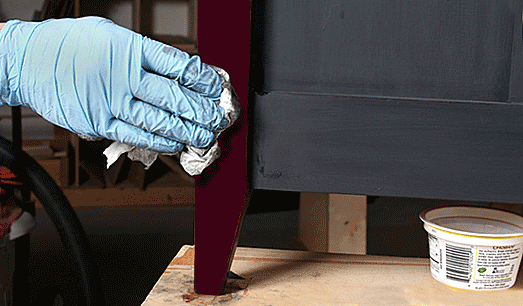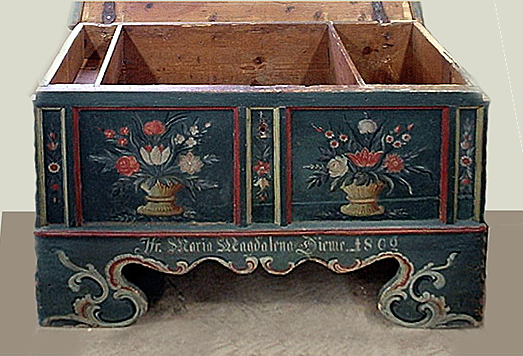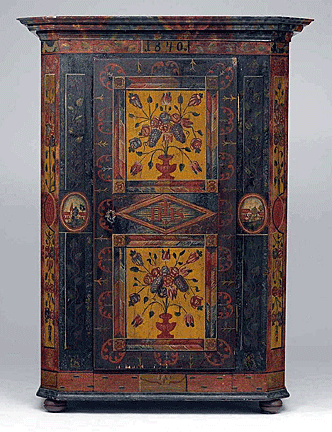
Here you'll find articles
about caring for your
antiques and collectibles.
LATEST ARTICLE____________________________________
Caring for
Antique Painted Furniture
by Bob Brooke
Unlike stained wooden antique furniture, painted pieces extra special
care. To preserve the wood, furniture needs to be coated with some sort
of protective covering against abrasions, spills and such. In this case,
itís paint.

In fact, many cabinetmakers in the17th and 18th centuries preferred to
paint their pieces rather than use stains and varnishes.
Contrary to the "strip and dip" approach to dealing with coatings so
prevalent in many commercial refinishing and restoration shops,
conservators and restorers attempt to preserve the coating on a piece of
furniture whenever possible. The idea is to intercede minimally and to
leave the surface as undisturbed as possible while stablizing and
preserving the original finish.
Cleaning Painted Furniture
Of all antiques, painted furniture is probably the easiest to keep
clean. Each week, dust or wipe clean the piece with a cloth dampened
with water. Be sure not to leave water spots on the surface, as they'll
dry and could leave permanent marks.

Before washing a piece of painted furniture, wipe it with a soft
lint-free cloth to remove built up dust. Mild soap and water and a soft
cloth are the basic tools youíll need to clean painted furniture. Never
use any type of degreaser, furniture spray or polish, or alcohol, or
acidic cleaning product that may discolor or damage the finish. And
avoid using wax as this may melt when it comes in contact with a hot cup
or bowl or when placed in direct sunlight close to a window.
For especially dirty pieces, dip a clean cloth into a solution of one
teaspoon of borax, two tablespoons of vinegar, 1/4 cup dishwashing
detergent and 1Ĺ cups hot water. Wring the cloth out until itís almost
dry and rub the surface using a gentle circular motion.
Special Cleaning
If your piece of painted furniture has stains on visible surfaces or
nicks and scratches on it, you'll want to make whatever repairs you can.
Gently sand down any mars, taking care not to damage more painted finish
than you have to. Carefully glue and clamp any loose joints.

Match the paint as best you can or select a new color of paint and
restore the piece to near-perfect condition. Add an oil finish for
greatest protection.
Avoiding Unnecessary Damage
 Clean
up spills or messes immediately with a damp lint-free cloth. If you do
get a water ring or scuff try buffing with a dry microfiber cloth. If a
water ring is being especially difficult, deep clean it using a soft
lint-free rag, with a simple homemade cleaner made with 16 ounces of
water, one drop of blue original Dawn, and a tablespoon of vinegar.
Collectors of antique furniture want their pieces to remain as close as
possible to how they were originally, which often included a coat of
paint. Over time, paint oxidizes. This fades the paint and gives it a
mellow look. Even if the paint dries to the point that it begins to
crack, it's better left alone. A little bit of craquelure is absolutely
acceptable and gives you a feeling of comfort that it's original. Resist
the temptation to "freshen" up a finish with lacquer over original
paint. Clean
up spills or messes immediately with a damp lint-free cloth. If you do
get a water ring or scuff try buffing with a dry microfiber cloth. If a
water ring is being especially difficult, deep clean it using a soft
lint-free rag, with a simple homemade cleaner made with 16 ounces of
water, one drop of blue original Dawn, and a tablespoon of vinegar.
Collectors of antique furniture want their pieces to remain as close as
possible to how they were originally, which often included a coat of
paint. Over time, paint oxidizes. This fades the paint and gives it a
mellow look. Even if the paint dries to the point that it begins to
crack, it's better left alone. A little bit of craquelure is absolutely
acceptable and gives you a feeling of comfort that it's original. Resist
the temptation to "freshen" up a finish with lacquer over original
paint.
<
Back to Caring for Your Collections
Archives
|
